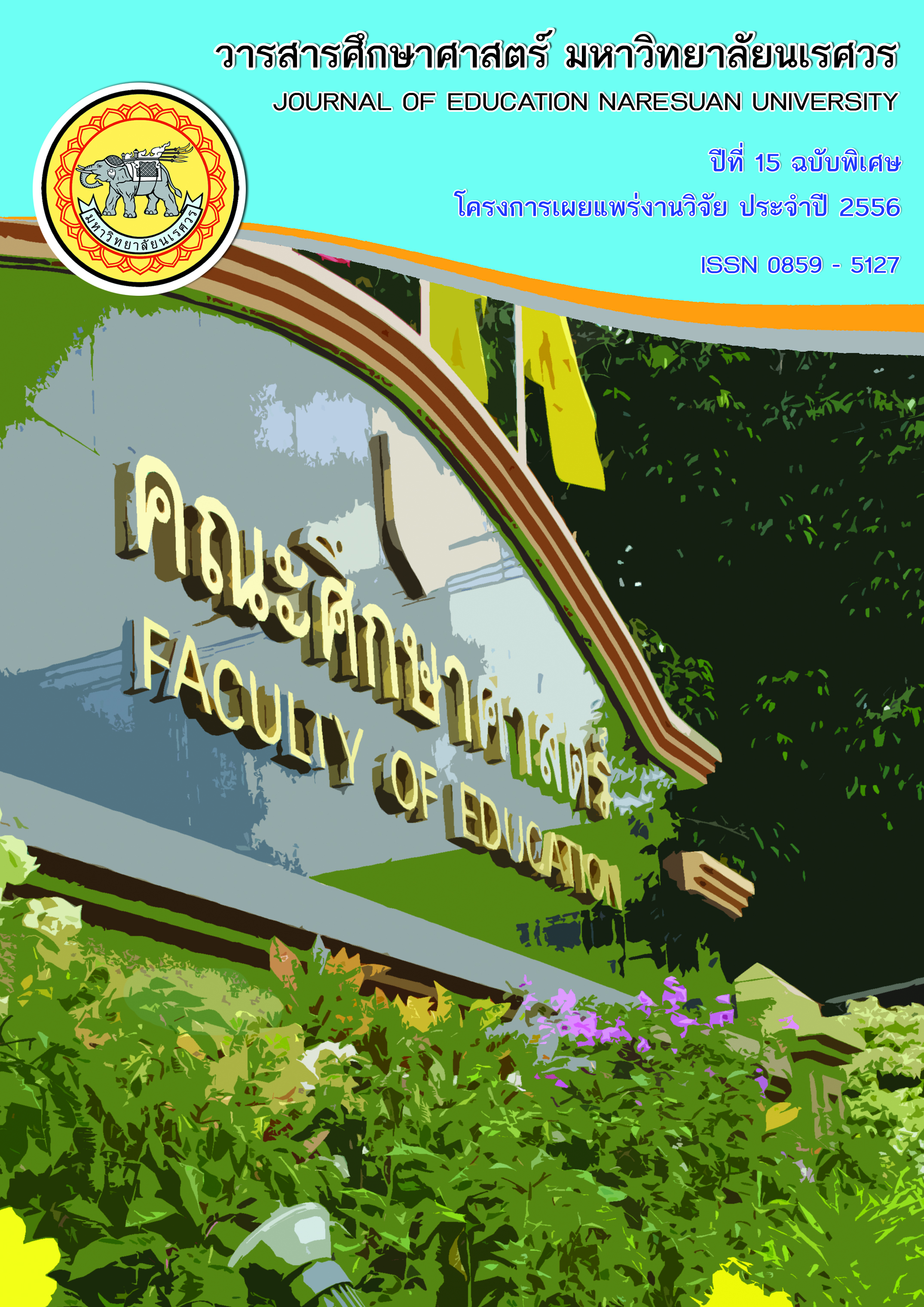การพัฒนายุทธศาสตร์สถานศึกษาขั้นพื้นฐานที่มีขีดสมรรถนะสูง สังกัดสำนักงานเขตพื้นที่การศึกษาประถมศึกษา
Main Article Content
Abstract
บทคัดย่อ
การวิจัยนี้เป็นการวิจัยและพัฒนา มีวัตถุประสงค์หลักเพื่อพัฒนายุทธศาสตร์สถานศึกษาขั้นพื้นฐานที่มีขีดสมรรถนะสูง สังกัดสำนักงานเขตพื้นที่การศึกษาประถมศึกษา วิธีดำเนินการวิจัยมี 3 ขั้นตอน คือ ขั้นตอนที่ 1 การศึกษาสภาพแวดล้อมและแนวทางในการพัฒนาสถานศึกษาขั้นพื้นฐานที่มีขีดสมรรถนะสูง สังกัดสำนักงานเขตพื้นที่การศึกษาประถมศึกษา จากการศึกษาสถานศึกษาที่มีแนวปฏิบัติที่ดี จำนวน 6 โรงเรียน และจากการสัมภาษณ์ผู้ทรงคุณวุฒิ จำนวน 8 คน ขั้นตอนที่ 2 การยกร่างยุทธศาสตร์สถานศึกษาขั้นพื้นฐานที่มีขีดสมรรถนะสูง สังกัดสำนักงานเขตพื้นที่การศึกษาประถมศึกษา โดยนำข้อมูลจากขั้นตอนที่ 1 และตรวจสอบความเหมาะสมของยุทธศาสตร์ด้วยการสนทนากลุ่ม ผู้ทรงคุณวุฒิจำนวน 11 คน ขั้นตอนที่ 3 การประเมินการพัฒนายุทธศาสตร์สถานศึกษาขั้นพื้นฐานที่มีขีดสมรรถนะสูง สังกัดสำนักงานเขตพื้นที่การศึกษาประถมศึกษา โดยการประชุมสัมมนารับฟังความคิดเห็นจากกลุ่มตัวอย่างซึ่งเป็นผู้บริหารสถานศึกษา จำนวน 62 คน
ผลการวิจัยพบว่า
1. การพัฒนายุทธศาสตร์สถานศึกษาขั้นพื้นฐานที่มีขีดสมรรถนะสูง สังกัดสำนักงานเขตพื้นที่การศึกษาประถมศึกษา ได้ยุทธศาสตร์ ประกอบด้วย 4 ยุทธศาสตร์ 16 กลยุทธ์ 106 มาตรการ 116 ตัวชี้วัด ดังนี้
1) ยุทธศาสตร์ที่ 1 การนำและการบริหารจัดการเชิงยุทธศาสตร์ ประกอบด้วย 4 กลยุทธ์ 35 มาตรการ 43 ตัวชี้วัด 2) ยุทธศาสตร์ที่ 2 การมุ่งเน้นพัฒนานักเรียน ผู้ปกครองและผู้เกี่ยวข้อง ประกอบด้วย 2 กลยุทธ์ 14 มาตรการ 15 ตัวชี้วัด 3) ยุทธศาสตร์ที่ 3 การมุ่งเน้นการพัฒนาบุคลากรสู่ความเป็นเลิศ ประกอบด้วย 6 กลยุทธ์ 39 มาตรการ 40 ตัวชี้วัด และ 4) ยุทธศาสตร์ที่ 4 การบริหารการเปลี่ยนแปลง ประกอบด้วย 4 กลยุทธ์ 18 มาตรการ 18 ตัวชี้วัด โดยผู้ทรงคุณวุฒิมีความเห็นว่า ยุทธศาสตร์สถานศึกษาขั้นพื้นฐานที่มีขีดสมรรถนะสูง สังกัดสำนักงานเขตพื้นที่การศึกษาประถมศึกษา มีความเหมาะสม
2. การประเมินการพัฒนายุทธศาสตร์สถานศึกษาขั้นพื้นฐานที่มีขีดสมรรถนะสูง สังกัดสำนักงานเขตพื้นที่การศึกษาประถมศึกษามีความเป็นไปได้อยู่ในระดับมากที่สุด
คำสำคัญ: ยุทธศาสตร์/ สถานศึกษาขั้นพื้นฐานที่มีขีดสมรรถนะสูง
Abstract
The research, characterized as research and development, aimed at developing strategies for high performance of the basic school under primary education service area office. The procedure followed 3 steps. The first step was to study about the environments and ways to develop high performance of the basic schools from the best practice of 6 schools, and interviewing 8 experts. The second step was to create and validate such the strategies of high performance of the basic school under primary education service area office it through group discussion of 11 experts. The last step was to evaluate those strategies used in the strategic development of high performance basic school under primary education service area office by the sample of 62 school directors. Findings received as follows.
1. The result of creating and validating the strategic of high performance basic school under primary education service area office revealed that it consisted of 4 strategic issues,16 strategies, 106 measures and 116 key performance indicators (KPIs). The above mentioned strategies were (1) strategic issues of leadership and strategic Management. This strategic issue consisted of 4 strategies, 35 measures and 43 KPls, (2) strategic issues of students and stakeholders Focus. This strategic issue consisted of 2 strategies, 14 measures and 15 KPls, (3) strategic issues of workforce focus. This strategic issue consisted of 6 strategies, 39 measures and 40 KPls and (4) strategic issues of Change Management. This strategic issue consisted of 4 strategies, 18 measures and 18 KPls. In validating the model, the experts concurred their opinions that the strategic of high performance of the basic schools under primary education service area office were appropriate.
2. The strategic development for high performance of the basic schools under primary education service area office was evaluated at a highest level of practicality.
Key words: Strategic/ High performance basic school
Article Details
The owner of the article does not copy or violate any of its copyright. If any copyright infringement occurs or prosecution, in any case, the Editorial Board is not involved in all the rights to the owner of the article to be performed.


